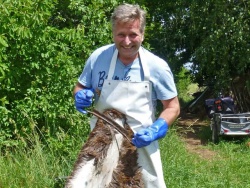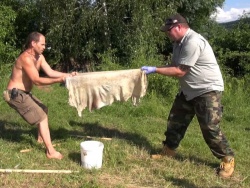How to tan leather yourself?
The tanning process is the most important step in the production of leather. It preserves the animal skins in order to prevent them from decomposing.
There is a lot of information about tanning on the internet and a lot of tanning instruction literature. In any case, you should thoroughly study them and carefully observe all regulations on safety, as well as disposal. Tanning leather in a tannery generally produces better results than home tanning. Thick leather can only be split with a splitting machine and also all other tannery machines and drums cannot be easily replaced by manual work.
The first step is to acquire the skins to be tanned. Please note the following:
- Many rangers and hunters do not use the skin. It's waste for them. Therefore, ask if you can get useful skins. Wild breeders, slaughterhouses or butchers can also help.
- The skins should be as free from natural markings and be as undamaged as possible. Often hides are cut wrong and have too many holes for good leather. Therefore, as far as possible, check for damages such as cuts, skin diseases or other imperfections.
- The hides must be very fresh, so that the decay process has not yet started.
Further preparations
- Select the place of tanning. Outside or in a shed, a garage etc. are suitable places. Ensure a plentiful source of water is readily available nearby.
- Tanning is wet and dirty. Choose suitable clothing (boots, apron, gloves) and work at temperatures that are not too hot or too cold to make the work enjoyable.
- Dispose of residues. This prevents stench and does not attract insects or other vermin.
This information is not enough to be able to get started without the help of somebody experienced. There are often different ways of how to proceed. "Practice makes perfect", and everyone must find the best method. Depending on the skin size, animal type, whether with or without hair, many different methods can be attempted.
Additional information
- Tanning leather
- Tannins
- Chrome tanned
- Vegetable-tanned leather
- Synthetic tanned
- Chamois leather
- Tawing with alum
- Brain tanning
Videos about the leather production
The leather production in a modern tannery.
The brain tanning process.
| Tanning methods |
|---|
| Chrome tanning - Vegetable-tanned leather - Synthetic tanning - Tanning with fats and oils |










 a kotori web solution
a kotori web solution